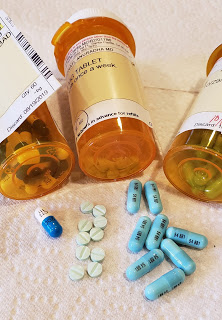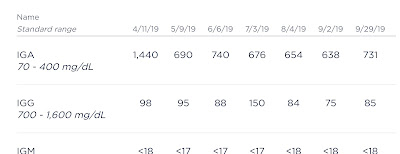10.9.19
Hello October!
So much to say, but I think I've said it all previously.
So much emotion, so much change, so much to process and digest.
So much sadness, yet so much to be glad for and grateful for.
Life changes each day, yet some things remain the same...
IGA up again ^
Coming close to 2x the High end of normal :((
M Protein going up too
@ .61
Normal = 0.0
Not happy about it, but not terribly worried...
I'm always amazed though that my organ status labs are good.
Creatinine good, etc.
WBC and RBC, etc always Abnormal, but my Dr isn't too worried.
My Abnormal is Normal for me LOL
I am a steady (dangerous) roller coaster, which isn't a "bad thing" ...
This past Monday's Velcade was injection # 52 !
That makes it a year I've been on it. Ahhmaaazing!
Cytoxan (Cyclophosphamide) was added a few weeks later, so it's almost a year I've been on this triplet combo, with the 40mg Dexamethasone!
I'm pretty proud of my body's ability to tolerate this, and that it's still effective after this amount of time. Hoping to remain on this for much longer, as it's not exactly fun, but it's not awful awful, and gives me Quality of Life several days a week.
My life is taking care of "everything" now. I'm pretty beat up from being in charge of Everything, "micromanaging" Everything and Everyone. Never wanted to be "Boss-Lady").
Reflecting back, it's amazing how "smooth" our life was before both our illnesses. Not to mention how much Jim did before and after my diagnosis. Think about your family, relationships, and distribution of daily life chores and activities. Think about who does what, and how much each does. We were such a great team. We never sat down and actually divided life chores up, things just evolved as they did. Now I literally do "everything". Yes I have help from amazing caregivers, my adult kids, and other "helpers", but I do Everything to keep our household and ranch running, us and the animals alive and eating. Everything... I do Everything!

Look in the hay, feed wagon/wheelbarrow... Yep, that's my Cytoxan pills and a protein shake. Things are so busy, I brought my pills outside with me to take as I did the horse chores. I had been to my Velcade infusion earlier, then errands, then a quick visit with friends, that had been planned before I knew my Monday caregiver Chris wouldn't be available that day. Our daughter Alissa came to "dad-sit" while I was gone, and I brought them food home, so I ran outside to do the chores, while she continued to watch him. I laugh and cry and at my life and what has happened to us. I have so much that is wonderful, yet so much loss...
Yes, I took my Chemo Pills, while feeding the horses! How funny, and ironic is that.
Until next time...
Hoping all is good with all of you, and if you're a Myeloma buddy, hoping your treatments are going well.






Hi Julie, oh how I identify with doing everything, same here, although Jerry is in recovery mode, we hope it continues. Still he does not have strength nor stamina and often finds himself napping away the afternoons. I always try to keep myself reassured that "I got this" and so I do, but doggone it. I was writing finally on my other blog, Pats Posts but I see that Google wants to sign me in here from my book blog. Don't know why and not going to worry or deal with it now. Your are amazing with the rollercoaster. I am going to send you a link from our local newspaper yesterday, to your FB page, about a local woman who is a breast cancer survivor so far, she too has a blog and a new book published. I think you will relate to her comments. .
ReplyDeleteThank you Pat for reading my blog and for our FB friendship :)) I'm happy to hear Jerry is recovery mode, but yes, we are all just trying to overcome these medical monsters, and get back to where we were... but not possible right...
DeleteStay well, and one foot in front of the other...
Thank you for checking in Pat, and for commenting and following my life xoxo